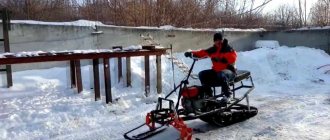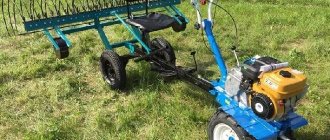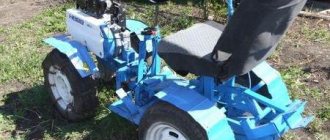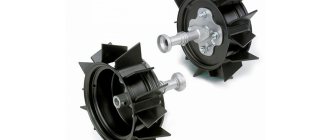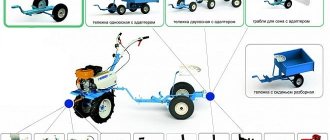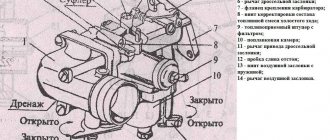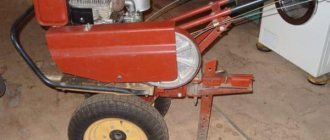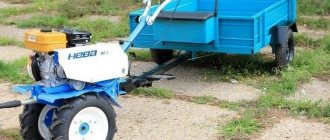This type of equipment is formally a smaller copy of a conventional tractor. As you know, a tractor is a vehicle, and to drive a vehicle you must have a driver's license and liability insurance. But does a similar rule apply to a walk-behind tractor? Of course, even if the answer to this question is positive, few would think of getting a license to drive across fields and beds. But there are often times when people use a walk-behind tractor to go to the nearest building materials store or simply go to throw out large garbage. Since the route will mainly run along public roads, there is a possibility of meeting a traffic inspector. In this case, the legal issue will be quite relevant.
What is the speed of the walk-behind tractor?
The speed of the walk-behind tractor depends on several parameters:
- walk-behind tractor class
- engine type
- availability of attachments
- type of gearbox
- wheel size
- the terrain in which the walk-behind tractor operates
As a rule, the class of a walk-behind tractor is associated with the type of engine; light models are equipped with gasoline engines with a power of up to 5 hp, medium ones with gasoline engines of 6-12 hp, heavy models with diesel engines with a power of 12 hp or more. Diesel engines are more powerful, so equipment with such engines will have greater speed.
Among budget models of mid-class walk-behind tractors, the common type of gearbox is 2 forward, 1 reverse; more expensive models have 6 forward and 3 reverse gears. The more gears, the higher the speed available.
The size of the wheels is important: the larger the wheel diameter, the faster the equipment moves.
Attachments such as plows and mowers can contribute to slower speeds. The speed of a walk-behind tractor with a trailer will also be lower, although the speed with a cart can be accurately calculated only by taking into account the speed and weight of the walk-behind tractor itself, as well as the weight and type of cart. Typically, the speed of a walk-behind tractor with a trailer does not exceed 10 km/h.
The more difficult the terrain, the more the speed decreases. For plowing in virgin lands, it is recommended to use weights that provide cross-country ability and help maintain speed. However, it is worth remembering that plowing heavy soils at increased speed is not recommended, as the quality of tillage decreases.
The fastest models
First, let's find out which walk-behind tractors are considered the fastest? Do domestic manufacturers have advantages or does the palm unconditionally belong to foreign competitors?
By the way, it is quite difficult to determine the undisputed winner in terms of maximum speed, because not only are there a great many models of walk-behind tractors from various manufacturers today, but it is also possible to independently modernize this multifunctional agricultural unit.
The number and speed indicators of a walk-behind tractor depend on the engine and gearbox installed in the unit.
Motoblocks MTZ-05, MTZ-12 have 4 speeds when moving forward and 2 in reverse. The minimum speeds correspond to the first gear; when switching to the next gear, it increases. For the above models, the minimum speed when moving forward is 2.15 km/h, when moving in reverse – 2.5 km/h; the maximum when driving forward is 9.6 km/h, when driving backwards – 4.46 km/h.
The Mobil-K G85 D CH395 / Grillo walk-behind tractor has a maximum forward speed of 11 km/h, and a reverse speed of 3 km/h. At the same time, the gearbox provides the ability to switch between three forward and two rear speeds. Don't forget that all these figures are true for unimproved models.
“Mobil-K Ghepard CH395” is a Russian-made walk-behind tractor, has a 4+1 gearbox, and can accelerate to 12 km/h.
The Ukrainian motor-block "Motor Sich MB-6D" can reach a speed of 16 km/h, the gearbox is six-speed (4+2).
Centaur MB 1081D unit is Russian, but is produced in Chinese factories. It is considered the fastest walk-behind tractor in the heavy class. Its maximum speed is as much as 25 km/h! Refers to diesel walk-behind tractors, unlike the models listed above - they run on gasoline.
Increasing the power of the walk-behind tractor
You can increase the speed of the walk-behind tractor in the following ways:
- replacing a gear pair;
- installation of wheels with a large diameter.
Increasing speed in the first way is a rather complicated process. Therefore, without knowledge and skills in this area, it is better not to do this yourself and contact a special service center. If you have the necessary skills, you can make the replacement yourself. Just like any other equipment, the walk-behind tractor has several speed modes controlled using gears. The walk-behind tractor moves at a speed of 2 to 15 km/h. The larger gear usually has 61 teeth, and the small one – 12. To increase the power of the walk-behind tractor, the gear pairs of the gearbox are replaced. Maximum speed can be achieved by increasing the number of teeth on the gear.
When replacing a gear, be sure to select the correct pulley. If the pulley is selected incorrectly, the walk-behind tractor may stop working.
How to make a walk-behind tractor go faster by changing wheels? Motor cultivators have a standard wheel size of 57 centimeters.
To increase the speed, you can install tires with a diameter of 70.4 cm; such a replacement will help speed up the walk-behind tractor several times. If the arches in which the tires are placed allow the installation of wheels with a larger diameter, you can try to increase them by a few centimeters.
How to increase the speed of MTZ
The article will tell you what characteristics a conventional walk-behind tractor has, as well as what needs to be done if there is a need to resolve the issue of how... Rating is available when the video has been rented. ... Which wheels are better to put on a trailer for a walk-behind tractor to make it go faster? Also…
More and more gardeners today are asking the question: how to tune a walk-behind tractor with your own hands? After all, if you turn to specialists in this matter, this can entail large financial costs. Ultimately, remaking a walk-behind tractor can even cost much more than purchasing a new unit.
Increasing cross-country ability and improving the walk-behind tractor
So, how to improve a motor cultivator with the help of weights. You can buy them or make and install them yourself. Weights are installed on the frame and wheels. Wheel weights are made of solid profiles and steel wheels. The body is weighted using special removable frames and a corner. Loads with different weights and configurations are attached to the frame.
So, sometimes you need to make a motor cultivator quite heavy, you can use reinforced concrete products.
Such loads can load the walk-behind tractor quite well. With the help of such simple devices, the range of application of technology is significantly expanded.
You can increase the capabilities of a walk-behind tractor and turn it into a snowmobile using tracks. To do this, you just need to install an additional axle with wheels and buy wide rubber tracks. Stoppers are attached to the inside of the tracks to prevent them from sliding off the wheels. Such a snowmobile will be useful on the farm in winter, when it is difficult to drive a car through huge snowdrifts, and in spring, when the ground is still too wet and the terrain is impassable for other equipment.
A homemade snowmobile can be equipped with a sled to transport property or feed for animals, or go fishing or hunting.
Do it yourself
How to make a creeper for a walk-behind tractor with your own hands? The design of the mechanism is very similar to a gearbox. Including it in the operation of the walk-behind tractor redistributes part of the traction force to additional attachments. The work on manufacturing the device can be divided into several stages:
- Preparatory activities. At this stage, the body for the future mechanism is selected, metal pipes, bearings, gears, steel sheets and screws are prepared.
- Shafts are made. The main material is round rolled hardened steel. Using machines, the workpieces are turned to the exact size, and grooves are also made. Shafts transmit torque, and radial bearings hold them.
- Install chains and sprockets. It is better to purchase this material in a store.
- After assembling the creeper housing, it is tested. If any extraneous sounds or creaks occur, work is suspended and the violations are corrected.
Advice. You should only undertake the manufacture of home-made devices if you have experience and, when assembling, strictly adhere to the algorithm of necessary operations.
Creeper device
The design of the mechanism is quite simple from a technical point of view and includes:
- frame;
- rotor shaft;
- flange bearing;
- bevel gear;
- pulley;
- steel parts and screws.
You can select a creeper for a walk-behind tractor at any specialized point of sale of agricultural machinery. If you make it yourself, you can save money and leave a considerable amount of money for anything else needed in the garden. Before manufacturing the structure, it is better to prepare drawings of all components with dimensions.
In this video we will look at installing a creeper:
How to increase the power of a walk-behind tractor using reverse speed
Setting the reverse speed on a walk-behind tractor is another way to improve the walk-behind tractor. The presence of reverse depends on the sizes and models. It can work on any type of equipment, it all depends on the tasks assigned to the equipment, be it a light or heavy walk-behind tractor, or a motor-cultivator. For equipment weighing up to 30 kg, there is no need for reverse speed, but on a heavier unit it is more difficult to weed without it.
Gearboxes are:
- gear;
- reverse gear;
- angular;
- downward
A gear reducer is a transmitter that operates between the wheels and the motor. The reverse gearbox consists of a clutch located between the gears and located on the main shaft. The corner is responsible for the operation of the transmission with the engine, which affects power. The reduction gearbox is responsible for reducing the speed, which helps increase power. The main task of this system is to provide reverse gear. To make this mechanism at home, you first need to make the case. Then select the necessary parts. But it’s better to buy a ready-made gearbox.
Carburetor Maintenance
The performance of the equipment depends on regular maintenance of the dosing unit. Its components are very sensitive to the quality of fuel and do not tolerate dirt. The main task of mechanics is to adjust idle speed. Secondary – cleaning of external and internal surfaces.
Most often, calibration jets become dirty. This occurs due to foreign substances entering the fuel system. They can be found both in gasoline and in the air entering inside. Replacing filters will help reduce the risk of contamination of the dosing device. Moving parts fail due to abrasion.
If “floating” speeds appear in the operation of the walk-behind tractor, dips in torque, or the unit begins to start intermittently, then it’s time to adjust the carburetor. By increasing the crankshaft rotation speed, the appearance of low idle speeds is “treated”. This is done by turning the adjusting screw under the throttle valve clockwise. If, on the contrary, the speed needs to be reduced, then turn the screw counterclockwise.
When adjusting the adjusting screw does not help, the system is disassembled and the fuel level in the float chamber is adjusted to normal, focusing on the position of the float. Exceeding the gasoline level is indicated by the appearance of dark smoke from the exhaust pipe, as well as traces of unburnt fuel on the spark plugs. Such malfunctions require adjustment of the float position: for this purpose, the spring mechanism of the needle valve is bent.
While the dosing unit is disassembled, its internal surfaces are cleaned and moving parts are replaced if they wear out.
Required materials and tools
First, you need to accurately determine the technical characteristics of the design: the type of transmission, its gear ratio, the distance between the shaft and the axle of the wheelset. The following tools will be needed for this work:
- welding machine;
- electric drill;
- a set of files and needle files;
- measuring instruments (calipers, ruler);
- yew;
- hammer.
The tool must be visually inspected and checked.
Important! It is strictly forbidden to use a faulty tool to avoid causing accidental injury to yourself and others.
How to remake and modernize a heavy Neva walk-behind tractor with your own hands: we explain point by point
A walk-behind tractor is an indispensable thing for farmers. Increasing the power of the walk-behind tractor allows you to increase the productivity of equipment and speed up agricultural work. You can improve your equipment either with your own hands or by purchasing the necessary equipment.
Design features of a mini tractor
When assembling a mini-tractor from a Neva walk-behind tractor, labor productivity at a summer cottage increases significantly. The advantages of such a unit are that a second wheel axle and a driver’s seat are installed.
Thanks to this, a person does not walk all day long, holding the handles of a walk-behind tractor, but sits in a comfortable seat and turns the steering wheel.
A mini tractor can be made in two ways:
- buy a ready-made adapter;
- improve the walk-behind tractor yourself.
In the first case, only cash expenses will be required. The adapter for the walk-behind tractor is a trailed trolley , which is equipped with a driver's seat and attached to the main unit using a rigid hitch.
If necessary, you can purchase attachments and semi-trailers . The disadvantage of this design is the lack of comfort for the operator.
If you improve the walk-behind tractor yourself, you get a mini-tractor that, in appearance and performance, will not differ at all from the factory models. In addition, the mini tractor can be equipped at your discretion and requirements.
Main assembly steps
Remaking a walk-behind tractor begins with starting to manufacture the frame.
The prepared metal is taken and, using a grinder, cut into pieces of the required length. The elements are fastened together using bolts or electric welding. After the frame is assembled, proceed to the chassis. When the engine is located in the front part, the track width should be determined by the base wheels of the walk-behind tractor. The rear wheels are attached to the frame using an additional axle, which is made from a piece of pipe of the required width. Bushings with bearings are pressed into its ends, onto which the wheels will subsequently be installed.
If the engine is located at the rear, the track width must be expanded, otherwise the minitractor will not receive the necessary balancing. To do this, the base wheels are removed from the walk-behind tractor and installed on a wider axle.
Assembly is carried out in the same way as in the previous version. The tires of a homemade mini-tractor must be equipped with lugs, which will improve the adhesion of the unit to the soil.
For steering, you can use the handles from a walk-behind tractor. In this case, the minitractor will look like a motorcycle. When driving in reverse, such control will cause a lot of inconvenience, so it is best to install an ordinary steering column on the tractor.
The driver's seat is mounted on a slide welded to the frame. It is best to use a seat from a passenger car because it is comfortable and adjustable. If the unit will be used in the dark, it is necessary to install side lights and headlights.
After the mini tractor is assembled, it is lubricated and run in. After this, the modification of the walk-behind tractor can be considered complete, and the mini-tractor is ready for use. If necessary, additional casing parts can be installed on the equipment.
Thus, for the convenience of performing country and agricultural work, you can create a mini-tractor from the Neva walk-behind tractor. Such a modification can be done by almost anyone who has even minimal skills. With the help of a homemade unit, you can cultivate large areas of land without any physical effort.
How to reduce the speed of a walk-behind tractor
To solve certain problems (plowing virgin lands and heavy soils), some models of walk-behind tractors may be too fast, in which case it is necessary to reduce the speed.
Without resorting to changes to the equipment itself, you can use the reduction gear, which is present on many models. This option allows you to reduce speed without reducing power, allowing you to work the soil more thoroughly.
To reduce speed, you can reduce the diameter of the wheels or replace the gear pair in the wheel reducer by changing the gears. Typically, gears of different sizes are installed, with a number of teeth of 61 and 12, in order to reduce the speed, it is necessary to replace them in such a way that the number of teeth on the larger sprocket increases.
A walk-behind tractor is an indispensable equipment for a gardener.
The walk-behind tractor is similar in design to a tractor, but with one axle. This is a device that you cannot do without when cultivating the soil. The term walk-behind tractor began to be used more often in the 80s; previously this technique was called a walking tractor or a single-axle tractor. It greatly facilitates the monotonous manual work of loosening the soil for planting various garden crops. In addition, the walk-behind tractor can perform several functions at a low cost. Work on this equipment occurs in this way: a person follows the walk-behind tractor, steering the steering wheel.
Walk-behind tractors are divided into wheeled and motor-cultivators. They are distinguished by the method of aggregation. The first one is switched into operating mode when the wheeled chassis moves. In the second, the wheel part is replaced by a milling cutter.
This equipment has a gasoline or diesel engine that drives the unit, and a wheel pair. For field work, you may need other devices that are connected through the towbar of the walk-behind tractor.
What are the minimum and maximum speeds of the walk-behind tractor and how to regulate them?
Today, walk-behind tractors are perhaps the most common type of mini-equipment for agricultural purposes. It happens that users of some models are no longer satisfied with the speed and performance of the unit. Purchasing a new model is quite expensive. In this case, you can try to upgrade your device.
A walk-behind tractor is a kind of mini-tractor, designed for carrying out various agricultural operations on relatively small areas of soil.
Its purpose is to perform arable work on small and medium-sized plots of land, cultivating the land using a harrow, cultivator, and milling cutter. Also, walk-behind tractors can process potato and beet plantings, mow grass, and transport cargo (when using a trailer).
It is also possible to use additional attachments to expand the list of tasks performed by this powerful unit, which is indispensable in many cases: a trailer-trolley for transporting cargo weighing up to half a ton, cutters, harrows, etc.
There are gasoline and diesel varieties of walk-behind tractors. For the most part, diesel units are more powerful than their gasoline counterparts. Gasoline-powered devices win in the price category - they are cheaper. But the choice largely depends on the size of the land plot and the frequency of use of this equipment, because diesel fuel is more affordable than gasoline.
Motoblock devices come in two- and four-wheel configurations. Not all devices have a reverse function.
Preparatory work
To make a mini tractor from a walk-behind tractor, you must first prepare drawings and kinematic diagrams. Thanks to the drawings, you can better imagine what kind of unit you will end up with, as well as decide on the necessary material.
Diagrams are needed in order to correctly calculate the load on the frame, as well as the traction force that will be required to perform work on the plot.
The location of the engine also plays an important role. It is best if the power unit is located at the rear, immediately behind the driver's seat.
Thanks to this, more reliable grip of the drive wheels with the ground is created, and the driver will ensure that weight is added to the front driven axle. As a result of this, the minitractor will not be able to tip over while plowing on hard soil.
Additional accessories
Walk-behind tractors are sold with a minimum number of components. However, a milling cutter and a standard plow are not enough to perform all agricultural work. How to improve a motor cultivator using scrap materials? With the help of tools that are found in every home, you can expand the capabilities of the walk-behind tractor. Equipment that you can make yourself:
- Installation of a rake on a walk-behind tractor for collecting debris, leaves, and hay. Such a simple device will speed up autumn field work and allow you to clear large areas of debris in a matter of minutes. To make a rake you will need: several meters of reinforcement with a cross section of 8-12 mm and a strip of sheet metal. The reinforcement is cut into pieces 10 cm long and welded to the plate in several rows with an interval of 3-5 cm. To increase maneuverability, the rake can be equipped with roller wheels.
- A trailer and cart will help transport large loads. The cart can be made from scrap materials - channel and old car wheels, metal profiles and boards. The clutch is made standard for both tractors and cars.
- If desired, you can make a potato digger, hiller and harrows, which will not be inferior in quality to purchased ones.
Plows for walk-behind tractors
Another device for cultivating soil using a walk-behind tractor is a plow.
The following types of plows are distinguished:
- The easiest to use is the single-hull one, also known as the Zykov plow.
- Reversible plow for walk-behind tractor: rotary or reversible. The upper part has a curved feather, which turns the soil over during plowing. A universal device that easily copes with plowing heavy soils. Quickly copes with the treatment of areas with clay and marshy soil.
- The rotary plow for a walk-behind tractor has a complex design. Depending on the number of ploughshares, there are two-body and three-body models. Active plowshares dump soil in one direction only, while passive plowshares level the beds and lift them. Tilling the soil with such a plow has a number of advantages: the soil is maximally saturated with oxygen; tire wear and fuel consumption are reduced; after processing there are no large clods of earth left.
- A rotary plow for a walk-behind tractor provides unlimited possibilities. During operation, the axis rotates, and with it the soil layers. It easily plows even very hard soil at a depth of about 30 centimeters. There are paddle, drum, shovel and auger plows. Devices of the first type are equipped with a rigid pusher and can consist of a spring plate or be combined. Units of the second type are equipped with a disk with blades that rotate during operation. A plow with a disc blade for a walk-behind tractor is suitable for work in early spring; it copes well with wet soil.
Any of the above plows can be made independently, taking into account the design features and following the instructions and diagrams. You can also improve an already purchased plow.
A rotary reversible plow for a walk-behind tractor copes with the processing of plots most efficiently, thanks to the optimization of the plowing process. And it is most in demand among agricultural workers.
Thanks to the expansion of capabilities, the walk-behind tractor becomes universal. It can be used to solve a variety of tasks from field work to snow removal in winter.
Equipment for the Neva
Today's market offers a wide range of attachments for the Neva walk-behind tractor. It can be either designed specifically for this model of the unit, or universal. There is always such an option as using homemade attachments for a walk-behind tractor. In this case, by independently developing a drawing of the attachment (if the craftsman has sufficient skill), it is possible to produce equipment that optimally meets specific requirements.
The Neva walk-behind tractor comes with a pair of plowing cutters, and the rest of the attachments are purchased separately.
By using the very necessary mounted potato planter for planting potatoes, you can complete the planting work much faster, thereby freeing up a lot of time for more interesting things.
An attachment for the Neva walk-behind tractor, like a hiller, will help in caring for root crops, allowing you to carry out all the work with the highest possible quality. It is designed both single-row and double-row. Such attachments can also be homemade.
A weeder will also make life easier for the gardener. With this attachment, there will be no need to manually remove weeds between rows of crop plants. After a couple of seasons of working with a walk-behind tractor with such attachments, the growth of weeds is significantly reduced.
It is combined with the Neva MB 2 walk-behind tractor and such attachments as a potato digger. With its help, it will be possible to harvest most root crops without damaging them as when using a shovel. If you watch a video about the operation of the Neva walk-behind tractor and its attachments, you can see the process of harvesting root crops.
Lugs are also classified as attachments for walk-behind tractors. They improve the cross-country ability of the unit and give it additional power when working on soft, viscous soil. This attachment for the Neva walk-behind tractor has a more than affordable price, and it is better not to refuse to purchase it.
The necessary attachments for the Neva MB walk-behind tractor will also be a trolley for transporting goods. In this case, in addition to helping with garden work, the car will also become a means of transport. If desired, using a drawing of attachments for a walk-behind tractor, you can make a trolley with your own hands.
The Neva 2 walk-behind tractor is also compatible with other attachments – a lawn mower. Using it, it will be possible not only to prepare the grass for drying hay, but also to tidy up the lawn.
Using attachments on the Neva walk-behind tractor, it is turned into a very versatile device. To reduce costs, you can find drawings of attachments and make it yourself. If you don’t want to tinker, you can buy used attachments.
Rules for driving a walk-behind tractor on public roads
This type of equipment is formally a smaller copy of a conventional tractor. As you know, a tractor is a vehicle, and to drive a vehicle you must have a driver's license and liability insurance. But does a similar rule apply to a walk-behind tractor? Of course, even if the answer to this question is positive, few would think of getting a license to drive across fields and beds. But there are often times when people use a walk-behind tractor to go to the nearest building materials store or simply go to throw out large garbage. Since the route will mainly run along public roads, there is a possibility of meeting a traffic inspector. In this case, the legal issue will be quite relevant.

